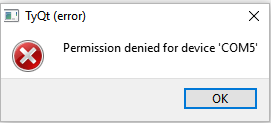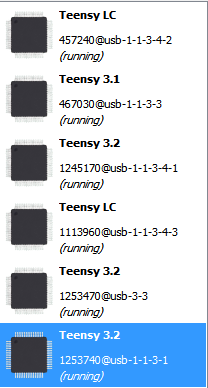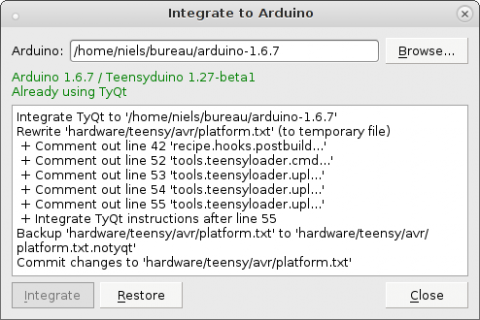Update: TyQt 0.7.0 is now out, you can find the last release in the
original post.
TyQt 0.7.0 is almost ready, and I wanted to release a pre-version for those interested:
- Windows:
https://www.dropbox.com/s/8mbwbyc4r2cp8ru/TyQt-0.6.3-278-gf419560-win32.zip?dl=0
- OSX:
https://www.dropbox.com/s/0516oj8m9z5tly9/TyQt-0.6.3-278-gf419560-osx.dmg?dl=0
The biggest improvement is the ability to work with multiple boards at once. Select multiple boards (using Ctrl), click on "File > Upload New Firmware" and pick all the firmwares you want. The first one compatible with each board will be used.
Here is an animated GIF to illustrate this:
http://imgur.com/O7T6eqJ
You can also reboot/reset multiple boards at once the same way. ATM, this functionality is not exposed on the command-line, which is what I want to change before releasing TyQt 0.7.0.
Other changes (unordered):
- Visual warning on task errors
- Board tags are now "<serial>@<location>"
- JSON output for `tyc list` using `tyc list -Ojson`
- Select board using device path in tyc/tyqt (e.g. "tyc upload --board @COM1")
- Faster firmware uploads
- Static binaries (no dependency on libty.dll)
- Replace "Upload" tab with "Settings" tab
- Show last uploaded firmware in board list
- Support El Capitan (osx)
- Add tyqtc to pilot TyQt (win32)
- Use short COM port names when possible (win32)
- Make README.txt/LICENSE.txt notepad-friendly (win32)
- Drop missing boards after a longer delay
- Add keyboard shortcut to clear monitor (Ctrl + Alt + X)
Main changes in release TyQt-0.6.3-155-g5be58ce:
- Various improvements to monitor performance to avoid buffer overruns
- Fix freeze of serial read in some cases on Win32
- Increase size of monitor scrollback in TyQt to 400000 lines
- Disable word-wrap in monitor text widget
- Avoid modal errors dialogs on startup for non-fatal errors
- Remove annoying LICENSE prompt from OSX bundles
Main changes in release TyQt-0.6.3-167-g1097f80:
- Read serial data from a dedicated thread to avoid stalls and overruns
- Allow selection of missing boards in TyQt
- Better handling of device close on Windows XP
Main changes in release TyQt-0.6.3-199-g81d2743:
- Improved command-line for TyQt (not complete yet)
- Fix tyqtc dropping output/error data
- Make TyQt autostart opt-in (--autostart)
- Add Arduino integration dialog
Main changes in release TyQt-0.6.3-222-gdef7db2:
- Board status icons replace the generic board icon
- Resizable board list using a QSplitter
- Hide harmless spurious I/O errors (generated when the Teensy is busy writing the previous binary chunk) when uploading
- Add Upload toolbar submenu with 'Upload all'
- Fix crash when selected firmwares are invalid in TyQt
Main changes in release TyQt-0.6.3-245-gc9d5dbd:
- Add board attach/detach function to better cooperate with other Teensy-related softwares
- Minor UI/GUI changes and improvements
- Fix crash with tyc in quiet mode
Main changes in release TyQt-0.6.3-250-g0a71b13:
- Keep board list width fixed when resizing main window
- Potential fix for
deadlock issue on Windows
Main changes in release TyQt-0.6.3-257-g76eca29:
- Support integration to legacy Arduino (1.0.x)
- Respect Arduino upload verbosity setting
Main changes in release TyQt-0.6.3-278-gf419560:
- Change board tag syntax to "<serial>-<family>"
- Extend board selection syntax to "[<serial>][-<family>][@<location>]"
- Allow board renaming/aliasing in TyQt
- Save board settings and alias
- Darker icons (main and status icons) and other minor UI changes
- Fix monitor send button (it never worked ^_^)
The code has changed quite a bit since TyQt 0.6.4 so this pre-release is probably not as stable. The project is now distributed under the terms of the MIT license.





